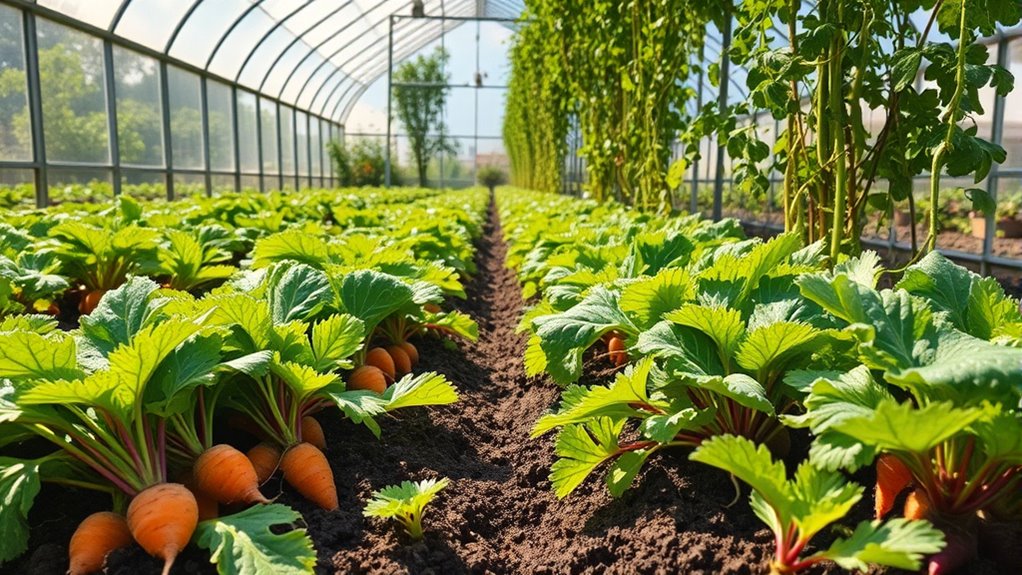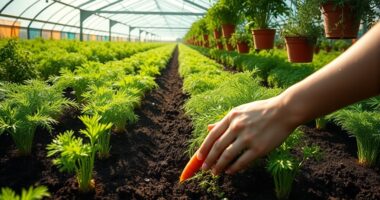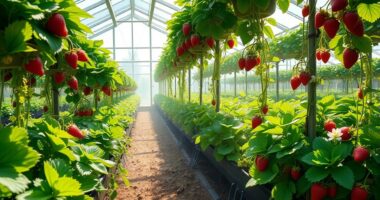To grow root vegetables in a greenhouse, start with deep, well-drained soil enriched with organic matter. Choose cool-weather varieties like carrots and radishes, ensuring proper planting depth and spacing. Maintain consistent watering, ideally with drip irrigation. Monitor for pests and diseases to keep your crops healthy. Incorporate crop rotation to boost soil health and productivity. Keep these tips in mind, and you might discover even more ways to maximize your greenhouse yield.
Key Takeaways
- Ensure deep, loose, and well-drained soil with a pH between 6.0 and 6.5 for optimal root vegetable growth.
- Select fast-growing root vegetables like radishes and turnips for quicker harvests in greenhouse conditions.
- Incorporate organic matter such as compost to enhance soil structure, fertility, and moisture retention.
- Implement consistent watering practices, using drip irrigation to reduce evaporation and maintain soil moisture.
- Practice crop rotation to improve soil health, disrupt disease cycles, and increase overall productivity in the greenhouse.
Understanding Soil Quality for Root Vegetables
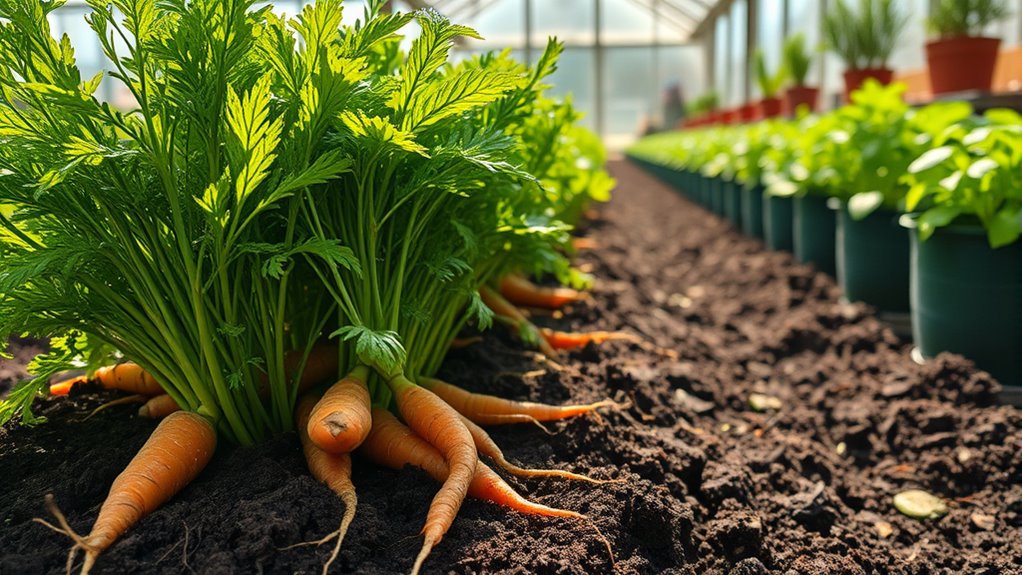
When it comes to growing root vegetables, understanding soil quality is essential for achieving ideal results. You need deep, loose, and well-drained soil for maximum growth.
Compaction can stifle root expansion and water infiltration, especially in intensive greenhouse settings. To improve soil structure, add organic matter like compost or manure. If your soil is heavy, mixing in sand can help. Aim for a pH between 6.0 and 6.5; soil testing will help identify nutrient deficiencies.
Compaction hinders root growth; enhance soil with organic matter and maintain a pH of 6.0 to 6.5 for optimal results.
Be cautious with fertilizers to avoid burning roots, and consider sidedressing. Maintaining soil health is key, so manage your organic matter carefully and practice crop rotation to prevent degradation.
With proper attention, your root vegetables will thrive!
Selecting the Right Root Vegetable Varieties
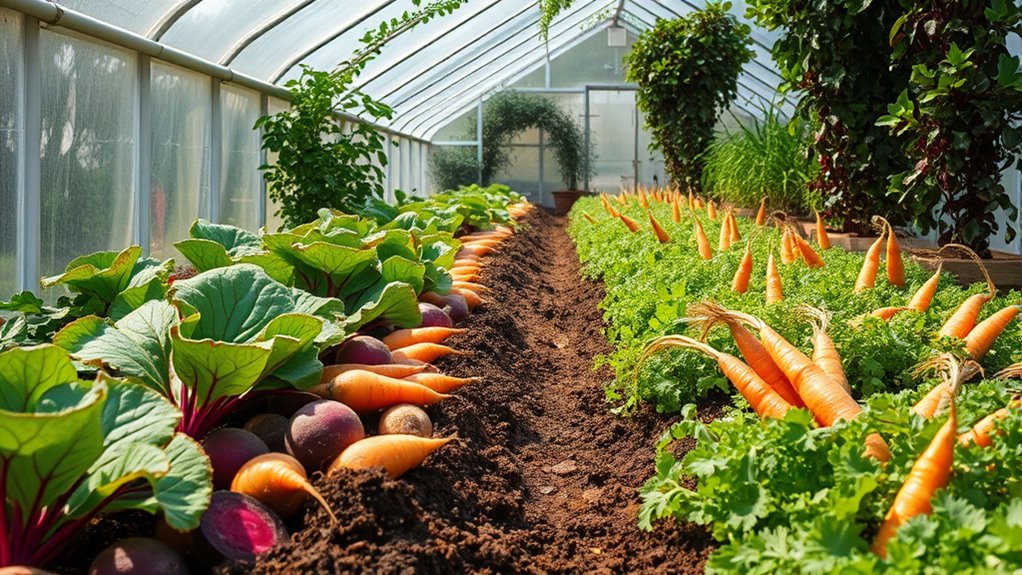
Selecting the right root vegetable varieties can greatly impact your greenhouse success, as it guarantees you grow produce that thrives in your specific conditions.
Focus on varieties like carrots, beets, and radishes that flourish in cooler temperatures. If you're keen for quick harvests, choose fast-growing options such as radishes and turnips, which mature in just 20-30 days.
Consider selecting disease-resistant varieties, especially those that combat issues like Alternaria in carrots. For smaller greenhouses, compact or dwarf varieties maximize your space and yield.
Finally, grow varieties that not only meet market demand but also offer unique flavors and textures, enhancing the diversity of your produce and ensuring a successful harvest.
Essential Soil Preparation Techniques
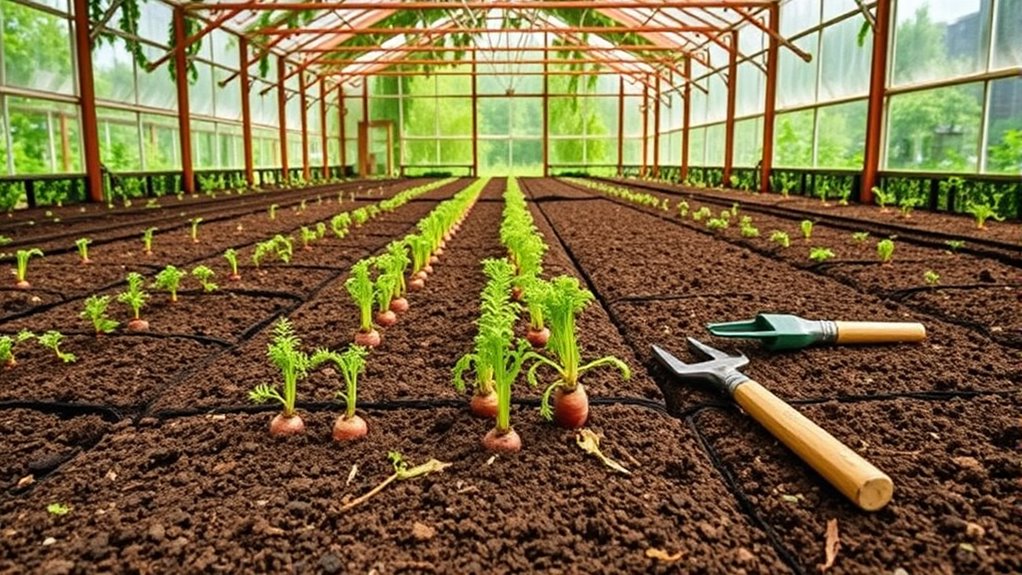
To guarantee your root vegetables grow strong and healthy, proper soil preparation is essential. Start by incorporating compost or well-aged manure to enhance soil structure and fertility.
Proper soil preparation is crucial for strong, healthy root vegetables; enrich your soil with compost or well-aged manure.
Keep your soil pH between 6.0 and 6.5 for ideal growth. Ascertain good drainage by mixing sand and garden loam with your compost, as this prevents waterlogging and root rot.
Use a rototiller to aerate the soil to a depth of 6-8 inches, and double dig if you want deeper root penetration. Clear away rocks, weeds, and debris to give your roots room to grow.
Finally, gently firm the soil after loosening it to ascertain good seed-to-soil contact, setting the stage for a successful harvest.
Effective Planting Techniques for Root Vegetables

Understanding effective planting techniques is essential for successfully growing root vegetables.
First, select varieties suited for greenhouse conditions, focusing on compact or early-maturing types. Pay attention to sowing depth; smaller seeds should be planted about 1/4 inch deep, while larger seeds need about 1 inch. Guarantee proper spacing—carrots, for instance, require 2-4 inches between plants.
Use containers that are at least 12 inches deep to accommodate root growth. Additionally, practice succession planting by sowing seeds every 1-2 weeks to enjoy a continuous harvest.
For taproots like carrots and beets, use loose, rock-free soil to support undisturbed growth. Following these techniques will enhance your success with root vegetables in your greenhouse.
Ideal Greenhouse Conditions for Growth
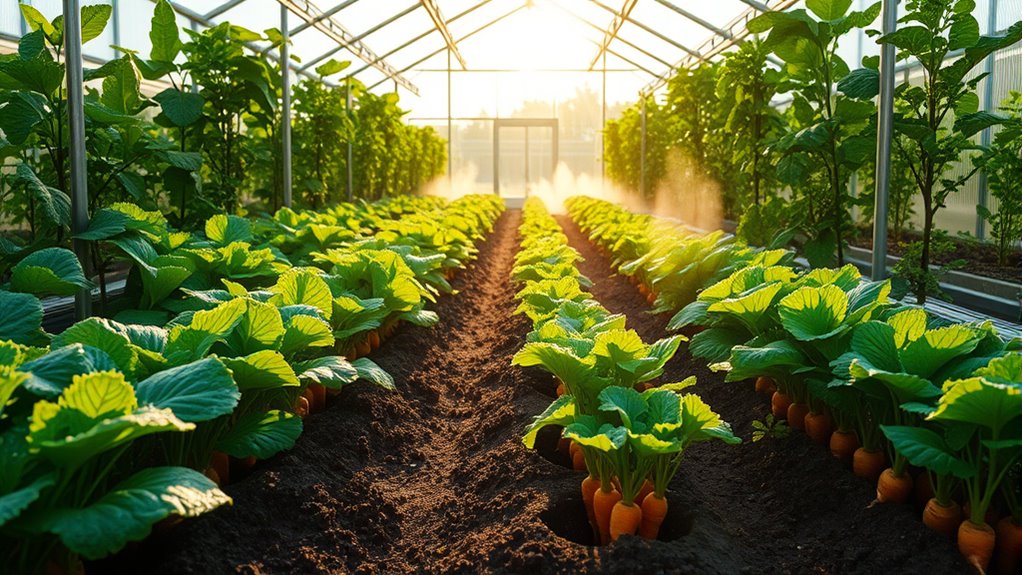
Creating the right environment in your greenhouse is vital for the successful growth of root vegetables. Aim to maintain temperatures between 64°F and 75°F for best growth, ensuring winter crops stay above freezing. For heat-loving varieties like sweet potatoes, keep temperatures above 70°F.
Consistency is key; automation can help manage temperature fluctuations effectively.
Automation plays a crucial role in maintaining consistent temperatures, ensuring optimal growth for your root vegetables.
Humidity should hover around 80%, but monitor it closely to prevent diseases. Proper ventilation is essential; utilize natural airflow and automated systems to control temperature and humidity.
Consider your lighting needs, too—some root vegetables can tolerate partial shade, while others may require supplemental lighting during winter months. With these ideal conditions, your root vegetables will thrive in your greenhouse.
Nutritional Needs and Fertilization Strategies
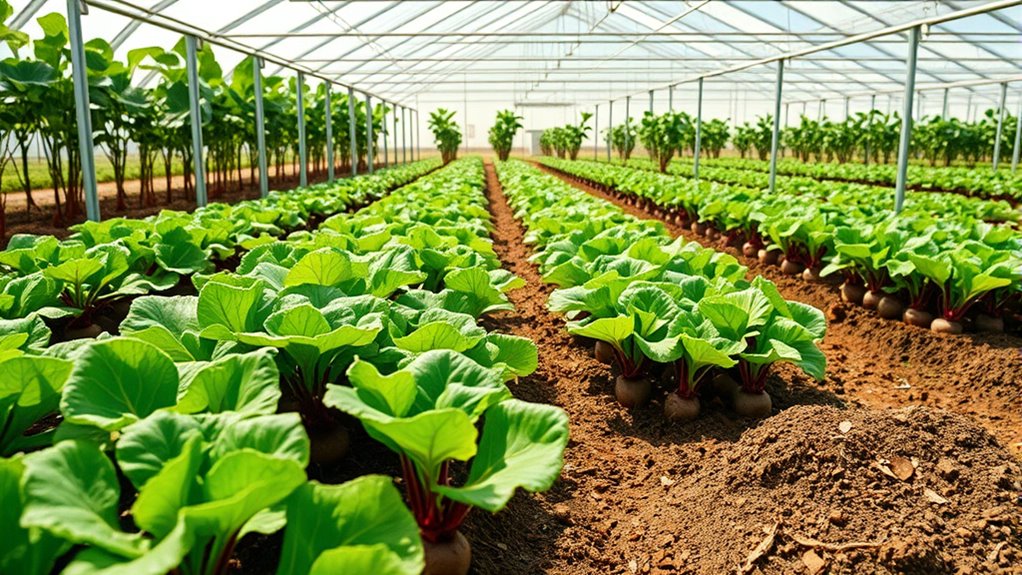
While growing root vegetables, it's crucial to recognize their specific nutritional needs and how to meet them effectively through fertilization. These plants thrive on nutrients like potassium, which regulates blood pressure, and B vitamins that support energy metabolism.
To guarantee ideal growth, use organic fertilizers such as compost or worm castings, avoiding harsh chemicals. Balance nitrogen, phosphorus, and potassium levels in your soil, and maintain a slightly acidic to neutral pH.
Be mindful not to over-fertilize, as this can lead to soft growth and pest problems. During winter, cut back on fertilizer to match the slower growth rate.
Maintaining Consistent Watering Practices

To guarantee your root vegetables thrive, it's essential to maintain consistent watering practices that suit their needs.
Using drip irrigation is an efficient choice, delivering water directly to the roots while minimizing evaporation. Regular soil testing can help you monitor moisture levels, ensuring you avoid overwatering or underwatering.
Remember, sandy soils drain quickly, so they need more frequent watering, while clay soils require less to prevent waterlogging.
Adjust your watering schedule with the seasons; you'll need to water more in summer and less in winter. Morning watering allows the soil to dry before evening, reducing disease risk.
Monitoring for Pests and Diseases
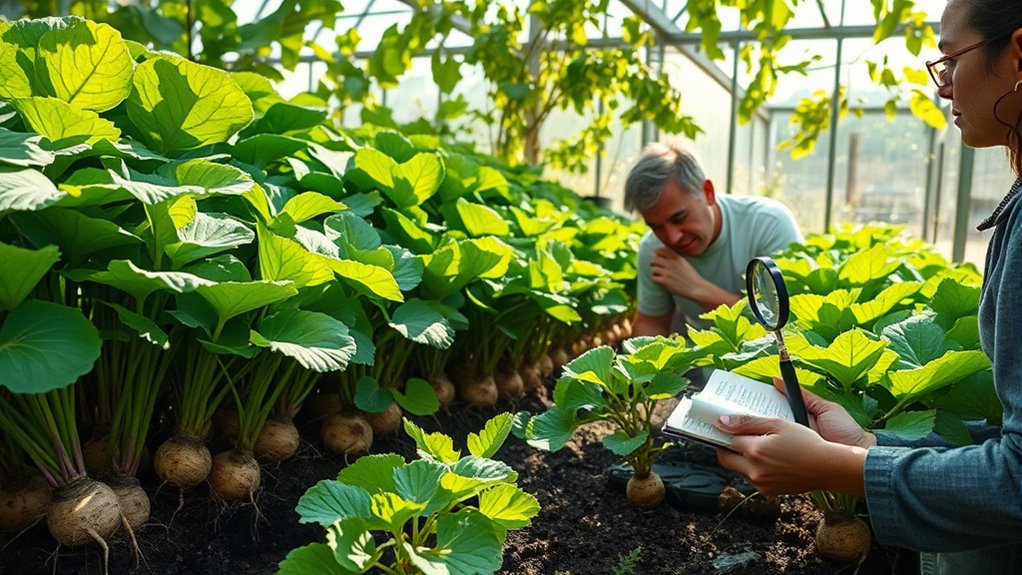
Monitoring for pests and diseases is essential for the health of your root vegetables, as early detection can prevent significant damage.
Early detection of pests and diseases is crucial for protecting the health of your root vegetables.
Scout your greenhouse weekly or twice weekly, inspecting at least three random plants per bench. Follow a consistent pattern to cover every area. Use sticky traps—yellow for aphids and whiteflies, blue for thrips—placing one per 1,000 square feet. Check these traps every three days and record your findings.
Incorporate indicator plants like tomatoes and marigolds among your crops, monitoring them daily for pest presence. Conduct thorough visual inspections for disease symptoms, documenting what you find.
Finally, adopt an Integrated Pest Management approach, combining cultural practices and biological controls to maintain a healthy greenhouse environment.
Best Practices for Harvesting Root Vegetables
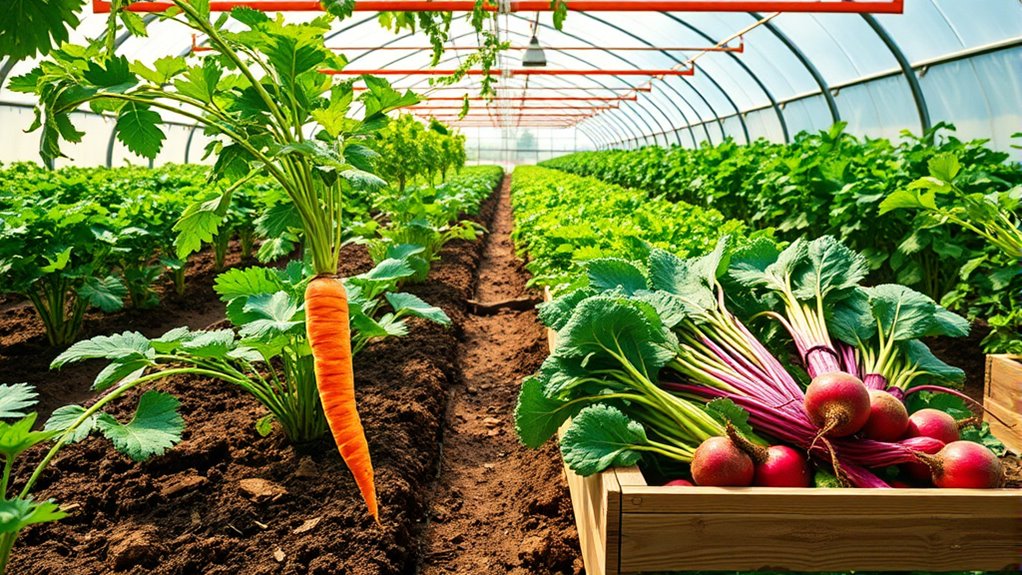
Harvesting root vegetables at the right time is essential for achieving the best flavor and texture. Pick them when they're mature but not overly large; otherwise, they may taste bitter or tough.
Use a garden fork to gently loosen the soil around the roots before pulling them out to avoid damage. It's best to harvest in moist soil, which helps prevent breakage. Handle the roots carefully to avoid bruising, as this can lead to spoilage.
For ideal flavor, harvest carrots when they're about an inch in diameter and beets when they're between 1 and 3 inches. Store your harvested roots in a cool, dry place to maintain their freshness and quality.
Importance of Crop Rotation for Soil Health

Maintaining healthy soil is just as important as knowing when to harvest root vegetables.
Crop rotation plays an essential role in enhancing soil health by improving its structure and fertility. By incorporating diverse root systems, you'll increase soil aggregation and porosity, which helps maintain moisture and nutrients.
Rotating crops also disrupts disease cycles, reducing the risk of soil-borne pathogens. Including legumes in your rotation boosts nitrogen levels, benefitting future crops.
Additionally, diverse crop residues support a wider range of beneficial soil microbes, enhancing biological health. This practice not only minimizes weed competition but also lowers the need for chemical inputs, promoting sustainable agriculture.
Embracing crop rotation can lead to a more productive and resilient greenhouse environment for your root vegetables.
Frequently Asked Questions
Can Root Vegetables Be Grown Year-Round in a Greenhouse?
Yes, you can grow root vegetables year-round in a greenhouse.
With proper climate control, you'll maintain the ideal temperature and humidity for peak growth. This environment protects your crops from pests and extends your harvest season, allowing for continuous production.
Just remember to manage soil quality and moisture levels carefully.
What Common Pests Affect Root Vegetables in Greenhouses?
Common pests that affect root vegetables include aphids, which suck sap and stunt growth, and fungus gnats, known for damaging roots.
Cutworms can harm stems and leaves, while earwigs often feast on young plants.
Thrips also pose a threat by weakening plants.
To protect your crops, monitor for these pests regularly and consider using biological controls or insecticides as needed.
Keeping a clean growing environment will further help prevent infestations.
How Can I Improve the Taste of My Root Vegetables?
Imagine biting into a crisp, flavorful carrot that bursts with sweetness.
To enhance the taste of your root vegetables, focus on soil quality and nutrient balance. Adding compost enriches the soil, while slightly stressing plants through controlled watering can enhance their flavor.
Regularly test your soil to guarantee pH and nutrient levels are ideal. Consider companion planting with herbs like chives, as they can elevate the taste of your vegetables considerably.
Are There Companion Plants for Root Vegetables in a Greenhouse?
Yes, there are great companion plants for root vegetables.
You can plant carrots alongside spring onions to deter pests like carrot root flies.
Beets thrive with radishes, which can repel cucumber beetles.
For potatoes, marigolds work wonders by keeping nematodes at bay.
By pairing plants with similar nutrient and moisture needs, you'll optimize space and enhance your garden's health.
This approach not only boosts yields but also creates a balanced ecosystem.
What Tools Are Essential for Growing Root Vegetables?
Imagine starting a treasure hunt in your garden, where the tools become your trusty companions.
You'll need a dibber to mark your planting spots, a hand trowel for digging up the earth, and a garden fork to loosen the soil.
Pruning shears will help you maintain plant health, while gardening gloves protect your hands from nature's challenges.
With these essentials, you're well-equipped to cultivate a bountiful harvest of root vegetables.
Conclusion
To sum up, growing root vegetables in a greenhouse can yield rewarding results when you prioritize soil quality, select the right varieties, and maintain ideal conditions. By preparing your soil, planting effectively, and watering consistently, you create an environment where your crops can thrive. Additionally, monitoring for pests and practicing crop rotation will enhance your soil health. Embrace these practices, and you'll enjoy bountiful harvests while nurturing your greenhouse garden for years to come.
